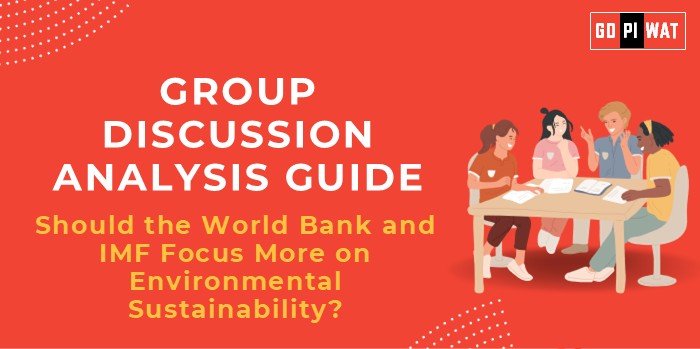📋 Group Discussion (GD) Analysis Guide
🌐 Should the World Bank and IMF Focus More on Environmental Sustainability?
📖 Introduction to the Topic
Opening Context: The role of the World Bank and IMF in global development is undeniable. However, the growing urgency of climate change raises questions about whether these institutions should pivot their priorities to environmental sustainability.
Topic Background: The World Bank and IMF were established in the aftermath of World War II to promote economic stability and development. While historically focused on economic growth and poverty reduction, they have faced criticism for neglecting environmental impacts. The 2015 Paris Agreement and the rise of the Sustainable Development Goals (SDGs) have redefined global priorities, compelling organizations to integrate sustainability into their agendas.
📊 Quick Facts and Key Statistics
- 🌍 Climate Financing Needs: $4.3 trillion annually by 2030 to achieve global climate goals (UNDP, 2023).
- 🌱 IMF Green Lending: Green finance made up only 1% of IMF lending in 2022.
- 💰 World Bank Funding: Committed $31.7 billion to climate finance in 2023, 37% of its total portfolio.
- 🌎 Global CO2 Emissions: Developing countries account for 63% of emissions, highlighting a need for climate-aligned development assistance.
🌟 Stakeholders and Their Roles
- 🏦 World Bank: Funding large-scale development projects, many with significant environmental footprints.
- 📊 IMF: Providing economic stability, often at odds with long-term environmental goals due to fiscal austerity measures.
- 🌍 Developing Nations: Balancing economic growth with environmental preservation, often constrained by funding and resources.
- 🌱 International NGOs: Advocating for environmental accountability in global financial policies.
🏆 Achievements and Challenges
✨ Achievements
- 🌳 Climate Commitments: The World Bank has doubled its climate finance since 2015.
- 💡 Policy Shifts: IMF introduced Resilience and Sustainability Trusts to fund green projects.
- 🌐 Global Leadership: Both institutions supported initiatives like the Forest Carbon Partnership.
⚠️ Challenges
- 📉 Inconsistent Focus: Climate-related funding remains a fraction of total financing.
- ⚖️ Development Trade-offs: Striking a balance between economic growth and environmental health is difficult.
- 📈 Global Comparisons: The European Union leads in green financing with its Green Deal, setting a benchmark for multilateral institutions.
📘 Case Study: The World Bank’s funding for India’s renewable energy projects showcases a shift toward sustainability but reveals challenges in project execution and scaling.
💬 Structured Arguments for Discussion
- ✅ Supporting Stance: “The World Bank and IMF must prioritize environmental sustainability to align with the Paris Agreement and prevent global economic destabilization from climate impacts.”
- ❌ Opposing Stance: “Environmental focus may undermine their core mission of poverty alleviation by diverting resources from immediate economic needs.”
- ⚖️ Balanced Perspective: “Integrating environmental sustainability without compromising economic growth can redefine their relevance in the 21st century.”
💡 Effective Discussion Approaches
- 🌏 Opening Approaches:
- “Over 50% of the World Bank’s projects in 2023 were linked to infrastructure—many with significant environmental risks.”
- “While climate finance grows, gaps in funding threaten the achievement of global climate goals.”
- 🤔 Counter-Argument Handling: “Acknowledging economic challenges is valid, but without environmental sustainability, economic progress may be short-lived.”
🔍 Strategic Analysis of Strengths and Weaknesses
- 💪 Strengths: Global reach, strong financial resources, experience in large-scale development projects.
- ⏳ Weaknesses: Bureaucratic delays, limited focus on non-economic indicators.
- 📈 Opportunities: Collaborations on green technologies, leveraging private sector funding.
- ⚠️ Threats: Political resistance, funding gaps for climate initiatives.
🎓 Connecting with B-School Applications
- 🌍 Real-World Applications: Green financing models for sustainable business ventures.
- 💬 Sample Interview Questions:
- “How can the World Bank and IMF adapt to address global environmental challenges?”
- “Evaluate the risks of prioritizing environmental goals over economic development.”
- 💡 Insights for B-School Students: Climate finance can drive innovation in business models, and sustainability metrics will become critical for global businesses.


